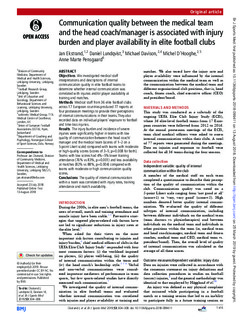| dc.contributor.author | Ekstrand, Jan | |
| dc.contributor.author | Lundqvist, Daniel | |
| dc.contributor.author | Davison, Michael | |
| dc.contributor.author | D'Hooghe, Michel | |
| dc.contributor.author | Pensgaard, Anne Marte | |
| dc.date.accessioned | 2019-04-26T09:29:00Z | |
| dc.date.available | 2019-04-26T09:29:00Z | |
| dc.date.created | 2018-10-08T14:30:53Z | |
| dc.date.issued | 2018 | |
| dc.identifier.citation | British Journal of Sports Medicine. 2018, 53, 304–308. | nb_NO |
| dc.identifier.issn | 0306-3674 | |
| dc.identifier.uri | http://hdl.handle.net/11250/2595663 | |
| dc.description | This is an open access article distributed in accordance with the Creative Commons Attribution Non Commercial (CC BY-NC 4.0) license, which permits others to distribute, remix, adapt, build upon this work non-commercially, and license their derivative works on different terms, provided the original work is properly cited, appropriate credit is given, any changes made indicated, and the use is non-commercial. See: http://creativecommons.org/licenses/by-nc/4.0/. | nb_NO |
| dc.description.abstract | Objectives: We investigated medical staff interpretations and descriptions of internal communication quality in elite football teams to determine whether internal communication was correlated with injuries and/or player availability at training and matches. Methods: Medical staff from 36 elite football clubs across 17 European countries produced 77 reports at four postseason meetings to provide their perceptions of internal communications in their teams. They also recorded data on individual players’ exposure to football and time-loss injuries. Results: The injury burden and incidence of severe injuries were significantly higher in teams with low quality of communication between the head coach/manager and the medical team (scores of 1–2 on a 5-point Likert scale) compared with teams with moderate or high-quality scores (scores of 3–5; p=0.008 for both). Teams with low scores had 4%–5% lower training attendance (76% vs 83%, p=0.001) and less availability at matches (82% vs 88%, p=0.004) compared with teams with moderate or high communication quality scores. Conclusions: The quality of internal communication within a team was correlated with injury rates, training attendance and match availability. | nb_NO |
| dc.language.iso | eng | nb_NO |
| dc.subject | athletic injuries / epidemiology* | |
| dc.subject | europe / epidemiology | |
| dc.subject | humans | |
| dc.subject | incidence | |
| dc.subject | interdisciplinary communication* | |
| dc.subject | mentors | |
| dc.subject | physical therapists | |
| dc.subject | physicians | |
| dc.subject | soccer / injuries* | |
| dc.title | Communication quality between the medical team and the head coach/manager is associated with injury burden and player availability in elite football clubs | nb_NO |
| dc.type | Journal article | nb_NO |
| dc.type | Peer reviewed | nb_NO |
| dc.description.version | publishedVersion | nb_NO |
| dc.rights.holder | © Author(s) (or their employer(s)) 2018. Re-use permitted under CC BY-NC. No commercial re-use. | nb_NO |
| dc.source.pagenumber | 6 | nb_NO |
| dc.source.journal | British Journal of Sports Medicine | nb_NO |
| dc.identifier.doi | 10.1136/bjsports-2018-099411 | |
| dc.identifier.cristin | 1618758 | |
| dc.description.localcode | Seksjon for coaching og psykologi / Department of Coaching and Psychology | nb_NO |
| cristin.unitcode | 150,32,0,0 | |
| cristin.unitname | Seksjon for coaching og psykologi | |
| cristin.ispublished | true | |
| cristin.fulltext | original | |
| cristin.qualitycode | 2 | |
